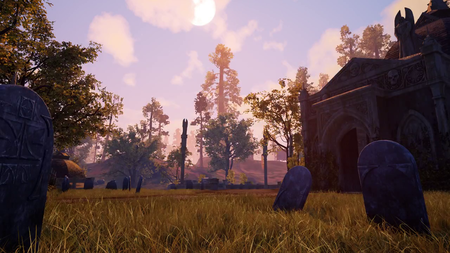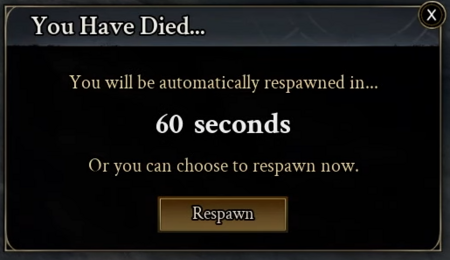Removing corruption
The primary means to remove corruption is through death. Multiple deaths may be necessary to remove all corruption.[2][3]
- Dying removes a significant portion of a player's corruption score.[4]
- Gaining experience will also slowly reduce a player's corruption score.[5][6][2]
- Any experience that's gained by the player, whether it be through achievements in crafting, or in adventuring, or through other types of achievements: All of that experience goes towards your adventuring class experience gained; and then some experience can dual purpose towards professions as well. So if I reach an achievement in my crafting profession and that grants me additional experience within that profession to rank up, it will also grant the same amount of experience over in my adventuring level; and to that point, anytime you gain adventuring experience you tick away at the corruption.[5] – Steven Sharif
- A quest may be utilized to reduce the player kill (PK) count of a corrupt player in order for them to accumulate less corruption score in the future.[7][4]
- Corruption duration is reduced in military nodes.[9]
Player corruption
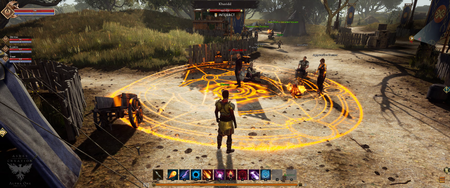
When you gain that corruption you have the potential of losing your completed items, your weapon, your armor, stuff that is very difficult to achieve; and then the other aspect of that is, that in order to deter basically players taking alternate characters and saying this is my PK alt, the more players you kill, the more corruption you gain, the higher your combat efficacy in PVP diminishes. If you're out there and you killed 20 players... you will not be able to perform in PVP any longer. You will need to take that character and go work off that corruption. The other aspect of corruption is that if you kill another player, who is a non-combatant and the level disparity between you and that player is great, you will gain a higher amount of corruption from that single kill. To the point where you should not be killing a level one character.[11] – Steven Sharif
If a combatant (purple) character, or their summon, kills a non-combatant (green) character, or any of their controlled entities, in Open-world PvP, they will be flagged as corrupted (red).[12][13][14] Corruption gained for killing controlled entities is a lower value than killing players.[12] Player corruption has been referred to as a status condition.[15]
- There is no incentive to go corrupt... There's zero incentive for a player to go red. It actually gives you negatives for doing that- very significant downsides.[16] – Steven Sharif
- The goal of the corruption system is to keep risk alive while significantly curtailing or deterring the ability for players to grief other players.[17][18]
- It is my expectation that the system will perform very well in keeping risk alive, but significantly curtailing or deterring the ability for players to grief.[18] – Steven Sharif
- A player's corruption score (corruption value) increases with each non-combatant player killed.[17][19][20][21] Corruption score has a scaling impact on the efficacy of a character's skills in PvP combat.[22][23] The higher the corruption score:
- The more skill and stat dampening applies until the corrupt player ultimately becomes ineffective at combat.[22][17][6][11][24][25] This dampening only affects PvP combat.[26]
- The more corruption you gain, the less effective you become in PvP and there's going to be a certain period at which point you have gained enough corruption that you're going to be gearless and you're also going to have a massive reduction in your PvP efficacy.[24] – Steven Sharif
- The higher chance of dropping of carried raw materials and gear (Weapons and Armor) when the corrupted player dies.[17][20][11][27][24]
- If you go on a murder spree and you have 10 pks under your belt then you might start feeling a significant dampening to your skill effects against other players. I don't want to give necessarily a number or curve for players to extrapolate prior to us having the ability to actually test these ideas and where those numbers are going to lie; but I would say what is the intent behind that dampening: The intent isn't to limit the fun of the player, the intent is to provide a give-and-take or a risk-versus-reward; and the risk of continuing down the road of accruing corruption is not only the loss of your gear and amplified death effects but also your ability to perform in that activity.[28] – Steven Sharif
- Corruption penalties occur as the corruption is gained.[29]
- Reward without risk is meaningless... Corruption is just another word for risk.[30] – Steven Sharif
- The wider the level disparity between the players, and the higher the attacker's PK value, the more corruption they gain.[17][6][19][20][21]
- Corruption value from PK'ing a non-combatant is based on level disparity along with the PKer's cumulative PK value.[19] – Steven Sharif
- Corrupt players suffer death penalties at four times the rate of a non-combatant.[17][20]
- Death penalties for corrupt players apply in every location, including naval PvP zones.[31]
- You can't necessarily time perfectly the damage or understand even the health of the player. Unless you were in their party you cannot see an opponent's health as well, so that's another component that adds risk..[32] – Steven Sharif
- Corrupted players remain corrupted when they enter naval PvP zones.[31][33][34]
- Corrupted players can be attacked regardless of other affiliations. This is something that will be tested during Alpha-2.[15]
- Corrupted players may kill bounty hunters without acquiring additional corruption score.[39][40]
- Corrupted player's combat penalties do not apply when battling bounty hunters.[39]
- Player to player trading, interacting with vendors or NPCs, and the ability to access storage is disabled for corrupted players.[41][17][42]
- Previously it was stated that corrupted players could not store items in public warehouses but could utilize private storage within their freehold.[17][42]
- Corrupted players will still be able to enter and leave their freehold buildings but may not deposit or withdraw items from storage.[41]
- There is a 60 second timer to logout while corrupt. Force-disconnecting the client during the cooldown will leave the character in-game.[22][43]
- Q: Will there be any large-scale consequences when many players in a group guild region religion etc become corrupted frequently or for an extended period of time?
- A: There are not group dynamics or mechanics that revolve around mass murdering people in the world. The corruption system is intended to deter mass murdering, not to provide incentives by which players can go out and gain corruption.[44] – Steven Sharif
- Q: If my guild has no one corrupted and your guild is like always killing people and always corrupted, will your guild have repercussions because they're corrupted versus my guild?
- A: No I don't think so either. And the reason why is we want to deter it, but we don't want to make the system meaningless; and if the deterrent becomes too heavy-handed then it's a system without a purpose. And I think that the intent behind the corruption is that like during a rise in passion and like anger and whatever you want to make this decision and do something and you'll suffer the repercussions later. But if those repercussions are just overwhelmingly bad and even anti-social in the sense that like your guild is like hey man you went corrupted and this gives us like corruption points on the guild, and like you're out of here, then people just aren't going to choose to use it; and then at which point might as well just take it out. So I think there's a healthy balance between the type of deterrent used.[45] – Steven Sharif
- Players do not lose gold upon death, no matter their corruption level.[46]
- Player corruption is different to the corruption found in corrupted areas.[47][48]
- Corruption has a visible effect on a player’s appearance.[49]
Player death
When a player dies they disintegrate into ash. The ashes contain any items lost by the player due to applicable death penalties.[51][52][53][25][54]
- Player flagging is not triggered by looting.[55]
- It might even be the case that their particular bag space doesn't have available location for a three-by-one log; and you're a lumberjack and they see you just chopping down these trees and you're like, there's no point in me engaging with this person, because I have nothing to gain due to my capacity.[58] – Steven Sharif
- There will be a period of time following a player's death before their mule despawns. Other players must kill that player's mule to be able to loot it.[59]
- If the mule dies its corpse will contain the same percentage of lootable items according to the player's death penalties.[59][60]
- Players do not lose gold upon death, no matter their corruption level.[46]
- Glint looted from a dead character by any other player, regardless of affiliation, becomes stolen glint. Character's who loot their own bodies will recover their glint in its non-stolen state.[61][62][52]
Death penalties

We don't have deleveling, instead what we have is experience debt. Now the more experience debt you accrue, the greater the detriment to your character; not to the point where you can not get out of the debt. There will always be a way forward to remove your debt.[67] – Steven Sharif
- Non-combatant (green players) suffer normal death penalties, which include:[25]
- Experience debt (negative experience). Experience debt scales to approximately 3 to 4 percent of the total XP for that level (subject to change based on testing).[68][69]
- Skill and stat dampening, such as Lower health and mana.[68][22][17][6][11][24]
- Reduction in loot drop rates from mobs.[70]
- Durability loss.[71][72][25]
- When players die and they take durability loss, our durability loss isn't like other games where it's a gold sink so to speak. It's a combination of both a gold sink and a material sink. So in a sense, even if you only have completed items, when you take that durability loss you are losing out on materials. It's just a debt to the materials that you are losing instead of the active loss of that material in your inventory. So now you are accruing a material debt if you want to repair and increase again the performance of those particular items that take that durability loss.[71] – Steven Sharif
- Dropping roughly 20-30% of carried gatherables, materials, and glint. The percentage values are subject to change based on Alpha-2 testing.[68][62][73][54][53][25] Glint drops as stolen glint on death.[62]
- Items made for final consumption are not dropped, such as consumable items created by the Cooking and Alchemy professions.[73]
- Combatants (purple players) suffer death penalties at half the rate of non-combatants.[25]
- Corrupt players (red players) suffer death penalties at four times the rate of non-combatants.[17][20]
- Corrupt players also have a chance to drop any equipped items based on their current corruption score, including dropping weapons and armor.[20][27][17][20][74][25]
- Any amount of corruption allows a player to drop equipped gear upon death. The higher the corruption the greater the chances.[75] – Steven Sharif
- Corrupt players respawn at random locations in the vicinity of their death, not at regular spawn points.[76] Non-corrupt players always respawn at the closest active respawn point (to their death).[77]
- Corruption penalties occur as the corruption is gained (not just at death).[29]
- Death penalties for corrupt players apply in every location, including naval PvP zones.[31]
Death penalties (mostly) do not apply to objective-based PvP (also called sanctioned events).[78][79][80][81]
- There will not be death penalties applied to event-based deaths. The penalties are in the outcome of the event. So your number of deaths is likely going to impact your ability to win that particular event and that's going to be the penalty. This is it to encourage players to opt in to the events right because the more participation we have the more fun it can be; and we understand that the community at large- there's already a risk versus reward component to these events. We don't need to stack on additional risk versus reward to inhibit kind of- to increase the barrier to entry for players who may not be as interested.[81] – Steven Sharif
- Gear degradation applies on death during Caravan PvP.[79][80]
- Previously it was stated that death penalties do not differ between PvP and PvE.[82]
Non-corrupt players suffer reduced death penalties in naval PvP (open seas) zones.[31]
- These penalties will be less than those for a green player.[83]
- Q: We know that the normal death penalty incurs a myriad of penalties for the player, but we don't know the numbers behind this penalty. For instance, what percentage of materials do players drop? What percentage of glint is dropped? How severe is the skill and stat dampening? What is the average time it will take a player to work off XP debt from one death?
- A: You're asking about percentile values. You're asking about time that it takes to recoup the percentage and whatnot. Any time that we're at a stage we're in now, and that in Alpha-2 we're going to be testing this, those values are the most subject to change. So to be clear, we're going to do [a] best-guess balance pass for Alpha-2 with the full expectation and understanding that the purpose is- and take into consideration player interaction with those numbers, and what feels best. So just off the bat, those values are not what we should be focusing on at this stage; but, to give you an idea where we are: First of all, when we're talking about dropping items that are in your material inventory, whether that be glint or that be other material types, we're talking roughly between anywhere from 20 to 30% of a stack is going to be lootable on a per-death basis. Now, that is a value that can change based off of the types of bags that you are using to carry those materials. In addition, there's other progression that can allow you, and some stats I believe, that can allow you to mitigate that value also. When we are talking about the percentage that's lost, or excuse me, not lost, the percentage of your level that is accrued as experience debt from death, generally you can expect that that's going to live around three to four percent of the level in accrued experience debt per death. However, additionally, there is a way to mitigate that percentage debt; and that is through the resurrection ability that's provided to Clerics. So, Clerics have the ability to resurrect their allies, and that resurrection will return a percentage that would have been accrued as experience debt. And that return percentage is predicated on the investment into the resability [sic], as well as the stat of the Cleric that is tied to the resurrection effect as well. So those can return percentages, so you can mitigate that to a degree. How long will it take you to recover that, and what stat dampening occurs? Anywhere within a level, if you acquire 100% experience debt for that level, you max out the experience debt, essentially, you don't ever buy that down, you're probably looking around a 20% stat efficacy dampener. So on average, if you're at 100% debt for a level, and you got to work all that off before you can start progressing at the level again, you're at around 20% overall stat dampening. Time it takes you to regain that debt is predicated on the level you're at and how you exp. So, that's a highly variable value.[68] – Steven Sharif
- Reduction in gear proficiency.[25]
Experience debt
Experience debt (negative experience) is a death penalty that scales to approximately 3 to 4 percent of the total XP for that level (subject to change based on testing).[68] This was previously stated to be 2 or 3 percent of the total XP for a max level player.[84][85][67][69]
- We don't have deleveling, instead what we have is experience debt. Now the more experience debt you accrue, the greater the detriment to your character; not to the point where you can not get out of the debt. There will always be a way forward to remove your debt.[67] – Steven Sharif
- Characters accumulate experience debt on death. This does not delevel characters, but does have detrimental effects until the debt is paid off.[67]
- Experience debt is the bite of not achieving success. If I die to a monster because my strategy was bad, because my performance was bad, because my planning was bad: all of that means that debt is the cost I pay for the bad choice.[84] – Steven Sharif
- Resurrection skills allow greater recovery of experience debt than resurrection scrolls.[68][86][87]
- When we are talking about... the percentage of your level that is accrued as experience debt from death, generally you can expect that that's going to live around three to four percent of the level in accrued experience debt per death. However, additionally, there is a way to mitigate that percentage debt; and that is through the resurrection ability that's provided to Clerics. So, Clerics have the ability to resurrect their allies, and that resurrection will return a percentage that would have been accrued as experience debt. And that return percentage is predicated on the investment into the resability [sic], as well as the stat of the Cleric that is tied to the resurrection effect as well. So those can return percentages, so you can mitigate that to a degree.[68] – Steven Sharif
- Maxing out experience debt for a level can result in roughly 20% stat dampening for that character. This percentage is expected to be highly variable.[68]
- Skill points accrue at specific XP milestones to avoid creating an imbalance with experience debt.[88]
- Experience debt is paid down by the player gaining experience. This applies even to max-level players. Rested experience will increase the rate that the debt is paid back.[89]
- Q: Does experience debt at max level interact with rested experience? So, let's say I have experience at max level, will I be able to use rested experience to gain the experience back?
- A: Yes. Rested experience is a modifier that occurs when you first receive the experience and then after that modifier happens where that experience goes to buy down the debt is what happens. So, if you have rested experience and you have experience debt and you go out to collect experience, you will be working that debt off faster because of the rested experience.[89] – Steven Sharif
See also
References
- ↑ Livestream, July 9, 2018 (20:41).
- ↑ 2.0 2.1 Interview, July 18, 2020 (44:35).
- ↑ 3.0 3.1 Interview, April 27, 2017 (0:17).
- ↑ 4.0 4.1 Interview, July 19, 2020 (30:51).
- ↑ 5.0 5.1 Livestream, April 28, 2023 (1:27:18).
- ↑ 6.0 6.1 6.2 6.3 6.4

- ↑

- ↑ Livestream, June 4, 2018 (2:18).
- ↑
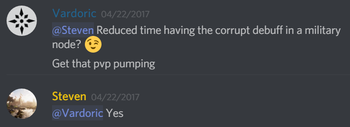
- ↑ Video, May 31, 2020 (5:29).
- ↑ 11.0 11.1 11.2 11.3 Podcast, April 23, 2018 (51:31).
- ↑ 12.0 12.1 Livestream, October 28, 2022 (1:35:36).
- ↑

- ↑ 14.0 14.1

- ↑ 15.0 15.1 Livestream, July 29, 2022 (1:07:20).
- ↑ Livestream, May 31, 2023 (1:30:45).
- ↑ 17.00 17.01 17.02 17.03 17.04 17.05 17.06 17.07 17.08 17.09 17.10 Livestream, October 28, 2022 (24:28).
- ↑ 18.0 18.1 Livestream, October 28, 2022 (13:53).
- ↑ 19.0 19.1 19.2

- ↑ 20.0 20.1 20.2 20.3 20.4 20.5 20.6 20.7 Interview, July 18, 2020 (41:54).
- ↑ 21.0 21.1 MMOGames interview, January 2017
- ↑ 22.0 22.1 22.2 22.3 22.4 22.5 Livestream, October 28, 2022 (26:48).
- ↑

- ↑ 24.0 24.1 24.2 24.3 Livestream, May 22, 2017 (42:33).
- ↑ 25.0 25.1 25.2 25.3 25.4 25.5 25.6 25.7 Podcast, May 5, 2017 (43:05).
- ↑ Interview, May 11, 2018 (5:05).
- ↑ 27.0 27.1 Livestream, November 17, 2017 (35:20).
- ↑ Podcast, April 11, 2021 (38:31).
- ↑ 29.0 29.1
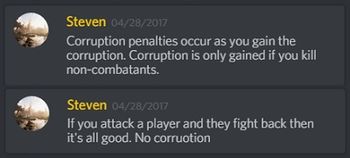
- ↑

- ↑ 31.0 31.1 31.2 31.3 Interview, July 9, 2023 (36:56).
- ↑ Livestream, January 30, 2020 (1:40:48).
- ↑
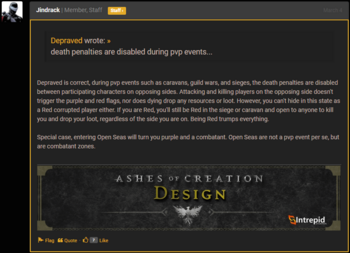
- ↑

- ↑ Interview, April 22, 2019 (54:40).
- ↑ Livestream, November 17, 2017 (29:45).
- ↑

- ↑ 39.0 39.1

- ↑ Interview, April 27, 2017 (1:18).
- ↑ 41.0 41.1 Livestream, February 24, 2023 (1:12:24).
- ↑ 42.0 42.1 Livestream, April 30, 2021 (1:14:49).
- ↑

- ↑ Livestream, August 27, 2021 (1:20:09).
- ↑ Livestream, August 27, 2021 (1:20:51).
- ↑ 46.0 46.1

- ↑ Livestream, March 31, 2023 (54:22).
- ↑ Livestream, June 25, 2021 (1:32:24).
- ↑ Interview, February 1, 2017 (39:33).
- ↑ 50.0 50.1 Video, February 29, 2024 (19:35).
- ↑ Livestream, September 24, 2021 (51:20).
- ↑ 52.0 52.1 52.2 Livestream, March 26, 2021 (1:07:33).
- ↑ 53.0 53.1

- ↑ 54.0 54.1 Interview, July 18, 2020 (27:11).
- ↑ Podcast, April 11, 2021 (34:41).
- ↑ Podcast, July 15, 2023 (26:31).
- ↑ Livestream, April 28, 2023 (1:18:48).
- ↑ Podcast, July 15, 2023 (28:28).
- ↑ 59.0 59.1 Livestream, January 29, 2021 (1:24:27).
- ↑ Livestream, September 27, 2018 (47:46).
- ↑ Livestream, November 30, 2023 (1:52:37).
- ↑ 62.0 62.1 62.2 Interview, September 10, 2023 (53:47).
- ↑ 63.0 63.1 Livestream, February 25, 2022 (1:06:45).
- ↑ 64.0 64.1 Livestream, April 29, 2022 (1:08:27).
- ↑ Livestream, July 28, 2017 (50:22).
- ↑ Livestream, March 28, 2020 (1:58:24).
- ↑ 67.0 67.1 67.2 67.3 Podcast, April 23, 2018 (49:21).
- ↑ 68.0 68.1 68.2 68.3 68.4 68.5 68.6 68.7 Livestream, March 29, 2024 (3:21).
- ↑ 69.0 69.1 Livestream, May 19, 2017 (13:37).
- ↑ 70.0 70.1 Ashes of Creation Forums - Former Lineage 2 PvP'er wanting to discuss PvP loopholes.
- ↑ 71.0 71.1 Interview, February 7, 2021 (13:14).
- ↑ Interview, July 29, 2020 (16:46).
- ↑ 73.0 73.1 Livestream, December 2, 2022 (1:26:02).
- ↑ Interview, May 11, 2018 (15:41).
- ↑

- ↑ Interview, April 27, 2017 (9:28).
- ↑ Livestream, June 25, 2021 (1:15:37).
- ↑ Livestream, February 24, 2023 (1:29:45).
- ↑ 79.0 79.1 Livestream, June 30, 2022 (1:14:52).
- ↑ 80.0 80.1 Livestream, August 27, 2021 (1:22:56).
- ↑ 81.0 81.1 Livestream, December 22, 2020 (1:13:51).
- ↑ Livestream, May 15, 2017 (36:23).
- ↑ Interview, July 9, 2023 (38:03).
- ↑ 84.0 84.1 Livestream, April 7, 2023 (40:30).
- ↑ Livestream, May 28, 2021 (1:50:50).
- ↑ Livestream, July 28, 2023 (1:01:30).
- ↑ Livestream, April 28, 2023 (1:22:57).
- ↑ Livestream, July 28, 2023 (1:03:27).
- ↑ 89.0 89.1 Livestream, September 29, 2023 (1:18:04).
